[Notes] CSCI 585 DB Relational Modeling
21 Jan 2020 | CSCI585, English/英文, NoteCredit to: Prof. Saty Raghavachary, CSCI 585, Spring 2020
outline
- That the relational database model offers a logical view of data
- About the relational model’s basic component: relations
- That relations are logical constructs composed of rows (tuples) and columns (attributes)
- That relations are implemented as tables in a relational DBMS
- About relational database operators, the data dictionary, and the system catalog
- How data redundancy is handled in the relational database model
- Why indexing is important
A Logical View of Data
- Relational database model enables logical representation of the data and its relationships
- Logical simplicity yields simple and effective database design methodologies
- Facilitated by the creation of data relationships based on a logical construct called a relation
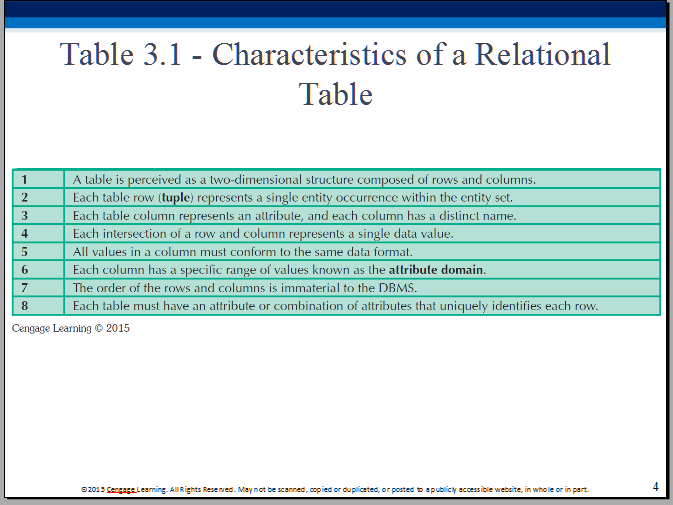
Keys
- Consist of one or more attributes that determine other attributes
- Used to:
- Ensure that each row in a table is uniquely identifiable
- Establish relationships among tables and to ensure the integrity of the data
- Primary key (PK): Attribute or combination of attributes that uniquely identifies any given row
Determination
- State in which knowing the value of one attribute makes it possible to determine the value of another
- Is the basis for establishing the role of a key
- Based on the relationships among the attributes
Dependencies
‘Full’ functional dependence is a “good” thing.
- Functional dependence: Value of one or more attributes determines the value of one or more other attributes
- Determinant: Attribute whose value determines another
- Dependent: Attribute whose value is determined by the other attribute
- Full functional dependence: Entire collection of attributes in the determinant is necessary for the relationship
e.g.
- STU_ID[determinant] ->[functionally determines] STU_LNAME[dependent]
- STU_ID,STU_LNAME -> GPA is NOT a ‘full functional dependency’ because the determinant contains an extra (unwanted) attr (STU_LNAME)
- STU_LNAME,STU_FNAME -> GPA is a ‘full functional dependency’ (assuming lastname,firstname is unique)
Types of Keys
- Composite key: Key that is composed of more than one attribute
- Key attribute: Attribute that is a part of a key
- Entity integrity: Condition in which each row in the table has its own unique identity
- All of the values in the primary key must be unique
- No key attribute in the primary key can contain a null
- Referential integrity: Every reference to an entity instance by another entity instance is valid. Whereas entity integrity has to do with a single table, referential integrity relates to two tables (loosely, ‘don’t allow invalid pointers’).
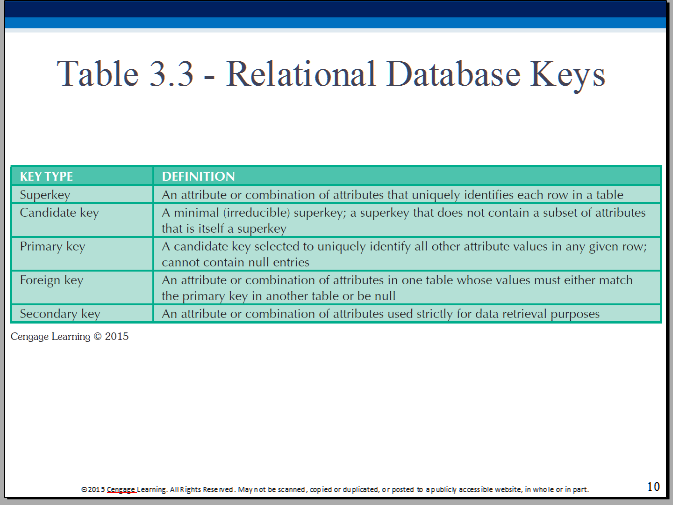
- primary (foreign) keys are a subset of candidate keys are a subset of superkeys (note - superkeys could be ‘wasteful’, ie. contain superfluous, non-needed attrs)
- simple keys vs compound keys vs composite keys
- natural keys - keys that are created from real-world entities (eg. for a US resident, their SSN could be a natural key)
- surrogate keys (just make up brand new unique keys)(opposite to the natural keys)
- secondary, or ‘alternate’ keys
You can read a bit more keys here.
Null
- Null: Absence of any data value that could represent:
- An unknown attribute value
- A known, but missing, attribute value
- A inapplicable condition
Ways to Handle Nulls
- Flags: Special codes used to indicate the absence of some value
- NOT NULL constraint - Placed on a column to ensure that every row in the table has a value for that column
- UNIQUE constraint - Restriction placed on a column to ensure that no duplicate values exist for that column
Relational Algebra
- Theoretical way of manipulating table contents using relational operators
- Relvar: Variable that holds a relation
- Heading contains the names of the attributes and the body contains the relation
- Relational operators have the property of closure
- Closure: Use of relational algebra operators on existing relations produces new relations (table(s) in, table out, ie. “closure”)
What if a table were a datatype (similar to an int, Vec3D, ComplexNumber, etc)?! Specifically, what operations could be perform on them (eg. similar to addition, square root on doubles)?!
Operations on tables
There are (only) EIGHT ‘relational set operators’ (defined by Ed Codd, at IBM, in 1970), which are all used to operate (“perform relational algebra”) on tables: Select, Project, Union, Intersect, Difference, Product, Join, Divide.
This is no exaggeration: these operators are the basis for SQL and the entire relational DB industry!
Relational Set Operators
- Select (Restrict)
- Unary operator that yields a horizontal subset of a table
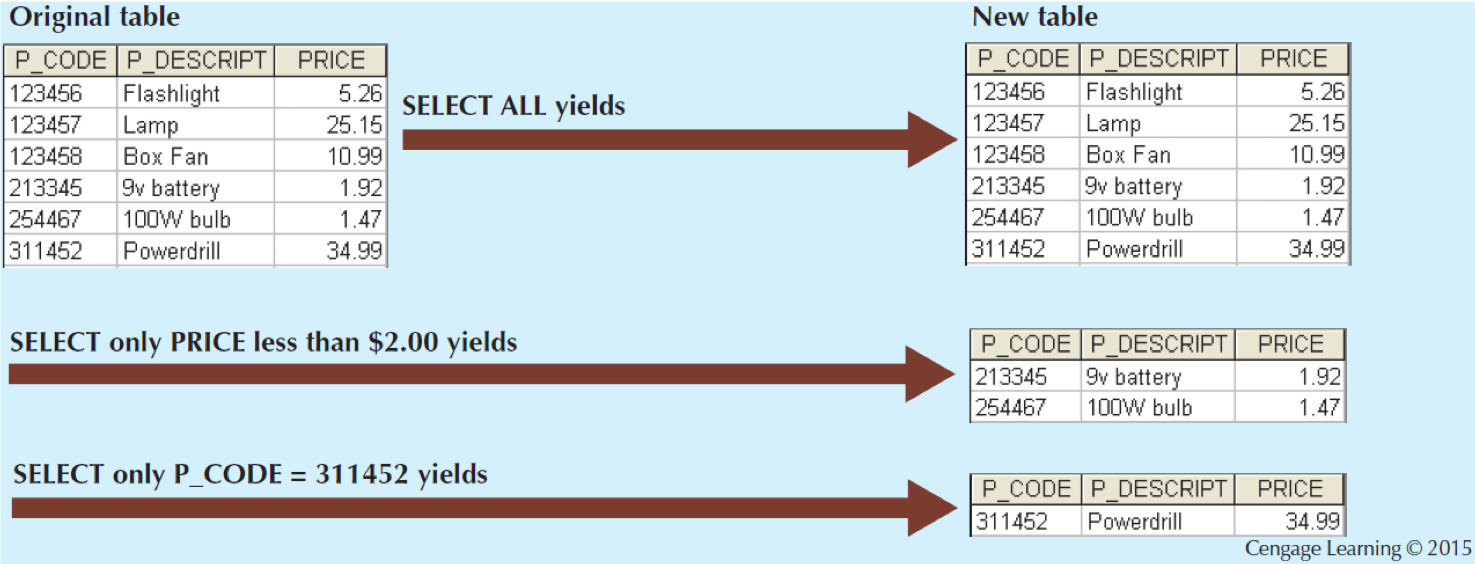
- Unary operator that yields a horizontal subset of a table
- Project
- Unary operator that yields a vertical subset of a table
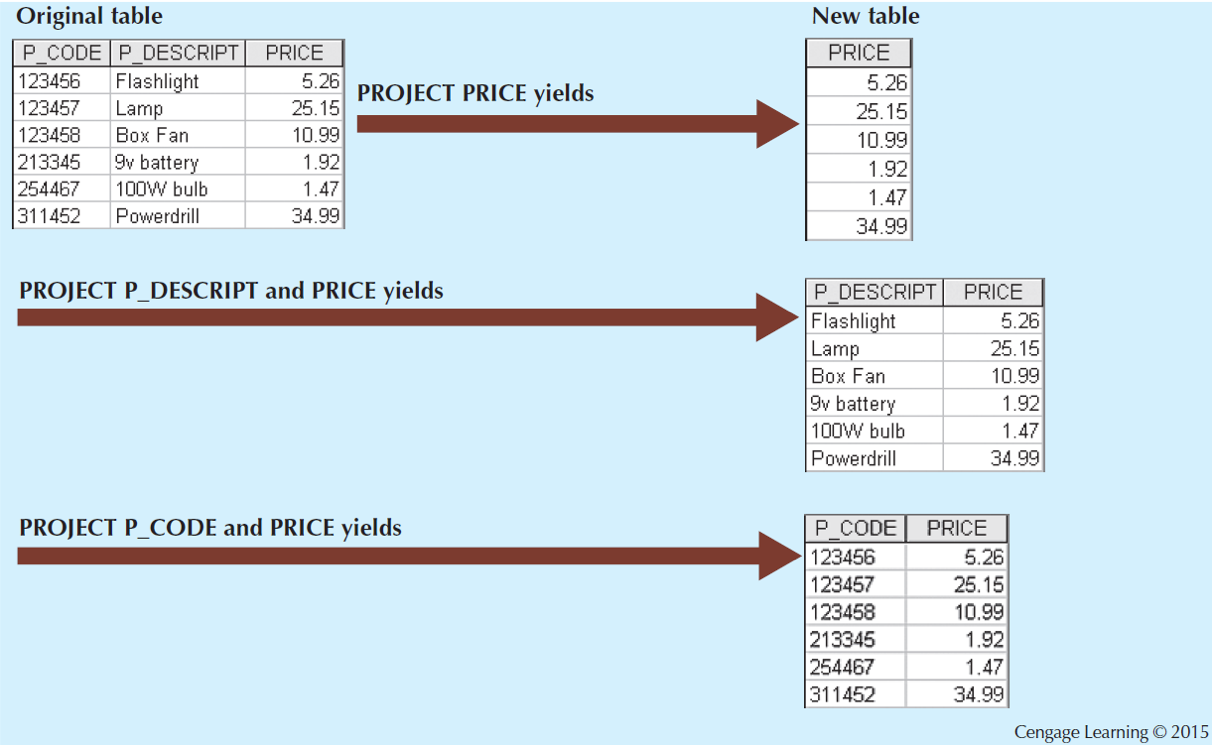
- Unary operator that yields a vertical subset of a table
- Union
- Combines all rows from two tables, excluding duplicate rows
- Union-compatible: Tables share the same number of columns, and their corresponding columns share compatible domains

- Intersect
- Yields only the rows that appear in both tables
- Tables must be union-compatible to yield valid results

Relational Set Operators
- Difference
- Yields all rows in one table that are not found in the other table
- Tables must be union-compatible to yield valid results

- Product
- Yields all possible pairs of rows from two tables
- Relational Set Operators
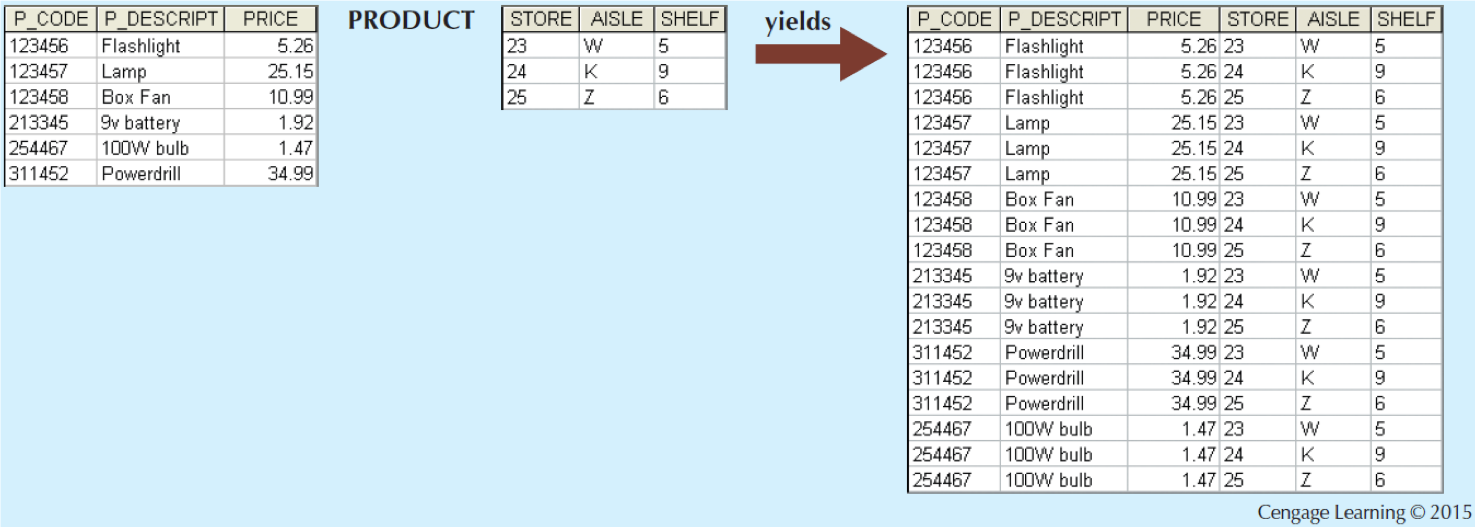
- Join
- Allows information to be intelligently combined from two or more tables

- Allows information to be intelligently combined from two or more tables
- Divide
- Uses one 2-column table as the dividend and one single-column table as the divisor
- Output is a single column that contains all values from the second column of the dividend that are associated with every row in the divisor
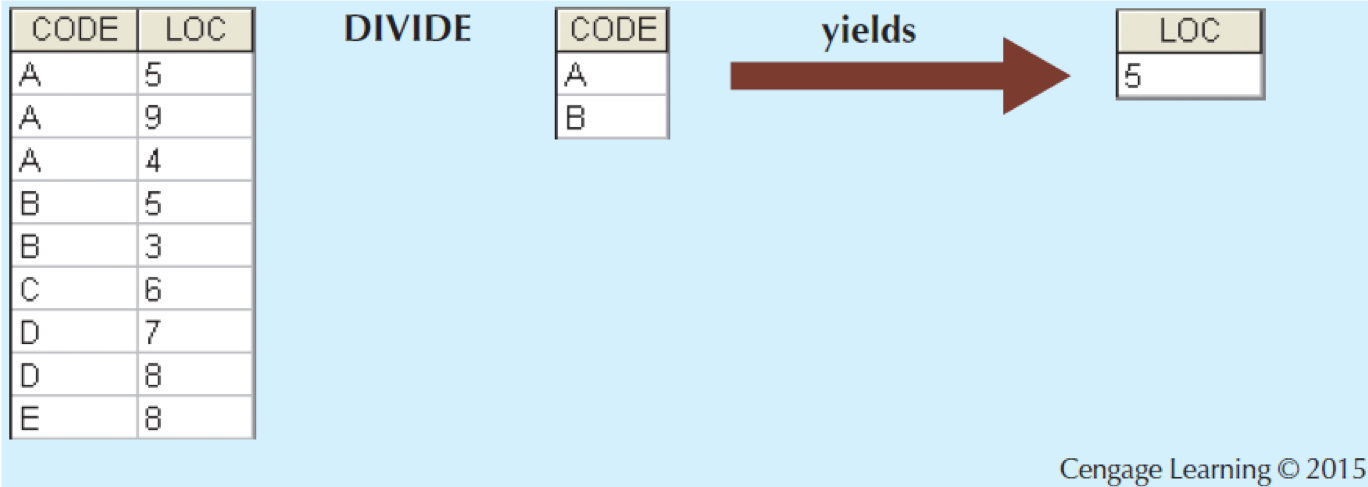
Types of Joins
- Natural join: Links tables by selecting only the rows with common values in their common attributes, A natural join links tables by selecting from two tables, only those rows that have common (identical) values for common attributes.
- These three steps result in a natural join: create product, select, project.
- Join columns: Common columns
- Equijoin: Links tables on the basis of an equality condition that compares specified columns of each table
- Theta join: Extension of natural join, denoted by adding a theta subscript after the JOIN symbol
- Inner join: Only returns matched records from the tables that are being joined
- Outer join: Matched pairs are retained and unmatched values in the other table are left null
- Left outer join: Yields all of the rows in the first table, including those that do not have a matching value in the second table
- e.g., Output all rows of the left (CUSTOMER) table, including ones for which there are no matching values in the join column in the other (AGENT) table
- Right outer join: Yields all of the rows in the second table, including those that do not have matching values in the first table
- e.g., Output all rows of the right (AGENT) table, including ones for which there are no matching values in the join column in the other (CUSTOMER) table
- Left outer join: Yields all of the rows in the first table, including those that do not have a matching value in the second table
Data Dictionary and the System Catalog
- Data dictionary: Description of all tables in the database created by the user and designer
- A data dictionary is metadata about tables (only);
- System catalog: System data dictionary that describes all objects within the database
- a system catalog, that includes (is a supeset of, although confusingly, the two are conflated in RL) the data dictionary, and more.
- Homonyms and synonyms must be avoided to lessen confusion
- Homonym: Same name is used to label different attributes
- Synonym: Different names are used to describe the same attribute asa
